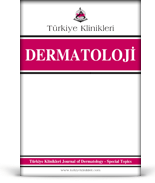Objective: Scabies is a common infestation that affects individuals of all ages and socioeconomic status. We aimed to contribute to epidemiological data in our country by evaluating scabies of which incidence has recently increased in our country. Material and Methods: The age and gender of 8,283 patients who applied to the dermatology outpatient clinic between January 01, 2017 and December 31, 2019 were evaluated retrospectively. Distribution of cases over years, months and seasons were evaluated. The results were analyzed statistically. Results: The incidence of scabies in 2019 were found to be higher than those in 2018 and 2017 (p0.05). Conclusion: According to the results of our study, there has been a gradual increase in the incidence of scabies, a disease that threatens public health. It should not be forgotten that this disease, which is more common in crowded families and in public areas, may cause epidemics in our country, which has received large numbers of immigrants in recent years.
Keywords: Scabies; incidence; epidemiology
Amaç: Uyuz, her yaştan ve sosyoekonomik durumdan bireyleri etkileyen yaygın bir enfestasyondur. Bu çalışmada, ülkemizde son zamanlarda görülme sıklığı belirgin olarak artan uyuz değerlendirilmekte ve ülkemizdeki epidemiyolojik verilere katkı sağlanması amaçlanmaktadır. Gereç ve Yöntemler: 01 Ocak 2017 ile 31 Aralık 2019 tarihleri arasında dermatoloji polikliniğine başvuran ve uyuz tanısı konulan 8.283 hastanın yaşı ve cinsiyeti geriye dönük olarak değerlendirildi. Uyuz olan olguların yıllara, aylara ve mevsimlere göre dağılımı değerlendirildi. Sonuçlar istatistiksel olarak analiz edildi. Bulgular: Yıllara göre hastalık insidans oranları karşılaştırıldığında, 2019 oranları 2018 ve 2017 yıllarına göre istatistiksel olarak anlamlı düzeyde yüksek bulundu (p0,05). Sonuç: Çalışmamızdan elde ettiğimiz sonuçlar, halk sağlığını tehdit eden bir hastalık olan uyuz insidansında kademeli ve belirgin bir artış olduğunu ortaya koymaktadır. Kalabalık ailelerde ve toplu alanlarda daha sık görülen bu hastalığın son yıllarda çok sayıda göçmen alan ülkemizde salgınlara neden olabileceği unutulmamalıdır.
Anahtar Kelimeler: Uyuz; insidans; epidemiyoloji
- Callum J, McDiarmid D, Gao Y, Armstrong M, Iavro E, Steer A. Prevalence of scabies in Sanma Province, Vanuatu. Trans R Soc Trop Med Hyg. 2019;113(8):500-2. [Crossref] [PubMed]
- Fuller LC. Epidemiology of scabies. Curr Opin Infect Dis. 2013;26(2):123-6. [Crossref] [PubMed]
- Chaudhry FR, Hameed K, Naz S, Min DA, Paolotizzani, Rivzi A, et al. Scabies prevalence and risk factors in Pakistan: A hospital based survey. Biomed J Sci &Tech Res. 2018;2(2). [Crossref]
- Osti MH, Sokana O, Phelan S, Marks M, Whitfeld MJ, Gorae C, et al. Prevalence of scabies and impetigo in the Solomon Islands: a school survey. BMC Infect Dis. 2019;19(1):803. [Crossref] [PubMed] [PMC]
- Aktaş H, Cebecik A. Changes in incidence and age distribution of scabies: A retrospective cohort study in a tertiary hospital. Arch Clin Exp Med. 2019;4(1):21-4. [Crossref]
- Heukelbach J, Wilcke T, Winter B, Feldmeier H. Epidemiology and morbidity of scabies and pediculosis capitis in resource-poor communities in Brazil. Br J Dermatol. 2005;153(1):150-6. [Crossref] [PubMed]
- Fraser TA, Shao R, Fountain-Jones NM, Charleston M, Martin A, Whiteley P, et al. Mitochondrial genome sequencing reveals potential origins of the scabies mite Sarcoptes scabiei infesting two iconic Australian marsupials. BMC Evol Biol. 2017;17(1):233. [Crossref] [PubMed] [PMC]
- Hicks MI, Elston DM. Scabies. Dermatol Ther. 2009;22(4):279-92. [Crossref] [PubMed]
- Goldust M, Rezaee E, Raghifar R, Naghavi-Behzad M. Comparison of permethrin 2.5 % cream vs. Tenutex emulsion for the treatment of scabies. Ann Parasitol. 2013;59(1):31-5. [Crossref] [PubMed]
- Vasanwala FF, Ong CY, Aw CWD, How CH. Management of scabies. Singapore Med J. 2019;60(6):281-5. [Crossref] [PubMed] [PMC]
- Rao MA, Raza N, Faheem M, Saleem MA. Comparison of efficacy of permethrin 5% cream with crotamiton 10% cream ın patients with scabies. J Ayub Med Coll Abbottabad. 2019;31(2):230-2. [PubMed]
- Karimkhani C, Colombara DV, Drucker AM, Norton SA, Hay R, Engelman D, et al. The global burden of scabies: a cross-sectional analysis from the Global Burden of Disease Study 2015. Lancet Infect Dis. 2017;17(12): 1247-54. [Crossref] [PubMed] [PMC]
- Hay RJ, Steer AC, Engelman D, Walton S. Scabies in the developing world--its prevalence, complications, and management. Clin Microbiol Infect. 2012;18(4):313-23. [Crossref] [PubMed]
- Karaman Ü, Enginyurt Ö, Dündar Y, Baykal MK, Gür S. [Infestation of Sarcoptes Scabie and pediculus capitis in terms of socio-economical status].ODU J Med. 2014;2:23-9. [Link]
- Çetinkaya Ü, Şahin S, Ulutabanca RÖ. The epidemiology of scabies and pediculosis in Kayseri. Turkiye Parazitol Derg. 2018;42(2): 134-7. [Crossref] [PubMed]
- Downs AM, Harvey I, Kennedy CT. The epidemiology of head lice and scabies in the UK. Epidemiol Infect. 1999;122(3):471-7. [Crossref] [PubMed] [PMC]
- Walton SF, Holt DC, Currie BJ, Kemp DJ. Scabies: new future for a neglected disease. Adv Parasitol. 2004;57:309-76. [Crossref] [PubMed]
- Korycinska J, Dzika E, Kloch M. Epidemiology of scabies in relation to socio-economic and selected climatic factors in north-east Poland. Ann Agric Environ Med. 2020;27(3):374-8. [Crossref] [PubMed]
- Özden MG, Ertürk K, Kartal SP, Yayli S, Göktay F, Doğramacı CA, et al. An extraordinary outbreak of scabies in Turkey. J Eur Acad Dermatol Venereol. 2020;34(12):e818-e20. [Crossref] [PubMed]







.: Process List